 (cont.)
(cont.) (cont.) (cont.) |
| INTERVIEW WITH FERNANDO DA COSTA PINHEIRO |
| Fernando da Costa Pinheiro is Master of Botany. He presented his monograph in Orchidaceae family and has developed a work in this area during the time he stayed at Herbarium Bradeanum. He was responsible for the survey of this family in Vila Dois Rios Florule Project. Here he tells us about the expeditions he did and the species he came across. Nowadays, he works at CNPq - Conselho Nacional de Desenvolvimento Científico e Tecnológico (National Council for Technological and Scientific Development), in Brasilia. | 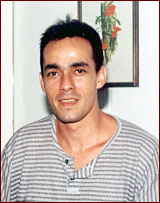 |
| ON:
Fernando, you have participated since the beginning of this great project,
could you tell us a little about it? Is it also about another botanical
families or just about Orchidaceae? Fernando: The integrated project with UERJ included all families collected in the region and is entitled "Studies about the vegetation of the coastal and terrestrial environment of Ilha Grande, RJ". It has been accomplishing by members of UERJ and Bradeanum Herbarium. We have already presented a panel about it during the 51st. National Botanical Conference which took place in Brasília, entitled: "Florule from Vila Dois Rios, Ilha Grande, Angra dos Reis Municipal District, Rio de Janeiro, Brazil". In this work, we presented preliminary data about the vegetation of this region, with 219 species inside 72 genera distributed among 52 families. Orchidaceae, Rubiaceae and Melastomataceae were the most representative. We got all this in just eight months of work! ON: How Bradeanum Herbarium (HB) got in this project and who participates in it? Fernando: After a meeting with UERJ's professors, HB has been invited to participate and in October 1999, Professor Fontella did the first request to go there. First, we should have to do a field work in order to recognize the area and we did it during the following November. It was a special moment, we were very encouraged by participating in a project in so wonderful area which is Ilha Grande, particularly, it was an accomplishment of a professional dream. Maria Isabel, Valéria Cassano, Joel Campos de Paula, Vera Regina and Norma Albarello from UERJ and me, Miriam Cristina, Luciana Cogliatti, Elisângela Medeiros from HB have participated in this project. It is worth to mention Sérgio Gonçalves who gave en enormous help in the work in the field with his great experience in speleology. With him, many improvisations were done, such as, for example, a portable aluminum ladder to get on the top of trees to collect epiphyte where we could not reach with the instruments. It was a fantastic idea! Initially, we throw up a nylon wire to the trunk with the help of a leaden sinker, then we pulled the rope by this wire and fastened it in a safe place. We had many trainees and technicians who helped in the expeditions because the HB group was not always able to participate completely. |
| ON:
Which species did you come across there? Fernando: Immediately we found a population of Huntleya meleagris completely bloomed and just after, a Xylobium variegatum. I remember that we were not prepared to collect and I carefully carried those specimens in my hands until to get the laboratory of CEADS (Center of environmental studies and Sustainable Development, Vila Dois Rios, Ilha Grande, RJ) to take photographs. We have planed the field works and the way of getting them viable, besides, each expedition would have a completely rapport with the list of the collected plants, date, schedules, members, etc. On: Which area is included in the orchids project? Fernando: The orchids project includes all areas visited: Vila Dois Rios which is placed at the ocean side of Ilha Grande and |
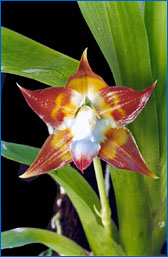 |
|
where
are located the ruins of the old penitentiary Cândido Mendes (Ilha
Grande Penitentiary). Species found in Caxadaço and in the trail
to Parnaióca were also included. It is, in fact, an ambition of us, trying to cover the most part of the State Park of Ilha Grande. The work presented as a panel during the 52.º National Botanical Congress, in João Pessoa, was entitled "Orchidaceae da Vila Dois Rios e Arredores, Parque Estadual da Ilha Grande, Angra dos Reis, RJ, Brasil" (Orchidaceae from Vila Dois Rios and surroundings, State Park of Ilha Grande, Angra dos Reis, RJ, Brazil). By this time, we mentioned the occurrence of 47 species within 28 genera. ON: How are the habitats? Fernando: According to our dearest Prof. José Elias de Paula, from UNB, there just are three habitats: terrestrial, marine and continental waters. However we will not get in this subject and we will mention that the region is composed by our exuberant Atlantic Forest, basically by slope forest and outcroppings. There are regions with typical characteristics of sand bank (restinga) but the area visited does not have this kind of vegetation. |
| ON: So we can say that the reserve is divided into Parnaióca, Jararaca, Caxadaço, Mãe d'água, Cavalinho woods? |
| Fernando:
In fact, the nomenclature used to identify the place is just to make easy
our fields data. For example, the trail to Parnaióca and the trail to Caxadaço, both places indicate beaches of Ilha Grande. Mãe D'água is more delimited because it is an area of waterfalls to gather water to provide Vila Dois Rios. The higher place and the most preserved is Jararaca (pit viper) wood which deserves the name. At the old dam I was nearly to be bitten by a young jararaca (pit viper). |
 |
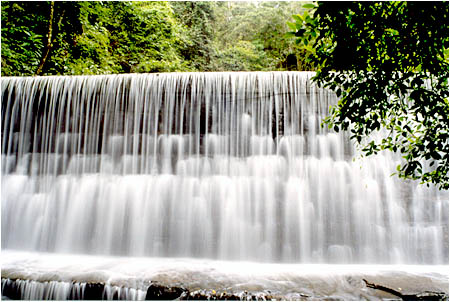 |
When
we were attempting to get up the dam, I notice the viper read to attack
my arm. By reflex, I avoided it and at the same time, Leonor pulled
my arm.
Result: I take my camera and shot the poisonous animal. Those are histories from the fields that we keep in memory and we remember them as always good moments. Of course, I was not bitten! |
| ON:
Which is the altitude and the climate of those places? Which are the characteristics? Fernando: The region presents a very bumpy relief. Papagaio Peak (959 m.s.m.) and Retiro mountain with 1.031 m.s.m are the highest points and by the path we got, it will be difficult to get there in just one day of walking. The highest point we got was at about 400 m.s.m. The climate is hot and humid without dry season with a medium annual temperature of 22,5º C, the maximum media is 25,7º C, in February and minimal media 19,6º C, in July. The annual pluviosity (rainfall) is at about 2.240 mm. It means, it rains a lot and we have already done an expedition under a strong storm. |
| ON:
You verified an interesting occurrence, Cirrhaea dependens. At what
altitude, it was found? Fernando: Cirrhaea dependens was a fantastic discovery. Sergio found it next to local we called "Recanto das Pedras" (Stones corner), at end of the trail found in Mata da Jararaca, at about 300 m altitude. He noticed a Cyathea (samambaiaçu - a kind of fern) with an exemplar of it with an inflorescence not opened. We succeeded in carrying it intact. I brought it into my home where the species bloomed and I could calmly shoot. That is what fascinates me in the field, those moments of by chance discoveries. |
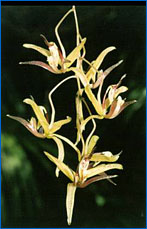 |
| ON:
Jararaca is the place where the orchids are more abundant? Fernando: Until this moment, we have collected 57 and most of them are coming from Jararaca wood. Unfortunately, there are many species which were not collected because they were not blooming by the time we found them. ON: How were those expeditions? Fernando: They lasted for 3 days or, sometimes, four. We always kept a whole day to go to Jararaca wood due to the fact that it is considered the most rich and the other days were distributed to another areas. We got out early and came back just before darken. |
|
ON: Regarding to the number of each species, are they abundant? Fernando: It varies a lot. Sometimes, the species are abundant but not so frequent. We noticed, for example, an immense population of Maxillaria marginata, on an only one rock in Mãe D'água, just there. Xylobium variegatum and Elleanthus brasiliensis are abundant and frequent, seen in many areas of Jararaca wood. Here we don't take into consideration fito-sociological patterns which are, by the way, another important work to be done. |
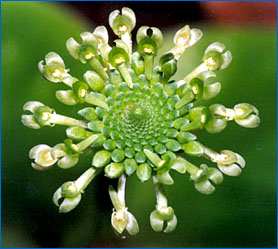 |
Others
species such as Cirrhaea dependens, Malaxis parthoni, Promenaea
stapelioides, Prosthechea fragrans and Cattleya guttata we
found just one plant. 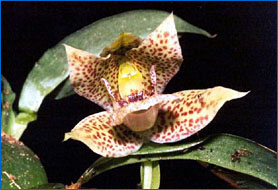 |
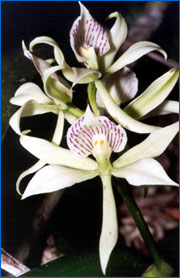 |
 |
ON:
And what about this Cattleya guttata? Fernando: It is another fantastic discovery. We just found an exemplar of this species, it means, it is not abundant or common in the place we passed through. In fact, I have been watching over this particular specimen and by the end of January 2001, we found it in entire blooming. It was one of the most vigorous exemplar of this species I've never seen. One inflorescence had 25 flowers, another with 20 and another smaller. I spent a film with 36 poses just with this plant. I could not lose this opportunity. The colors were rather evident, this plant was growing on the rock, exposed to the sun. We just collect the smaller inflorescence and I hope the plant is still there however it is very exposed due to the intense transit of tourists. Cattleya forbesii was found in Caxadaço beach, on rocks next to the breaking, where it is very common and also in the interior of the Jararaca wood where we came across just only one specimen. Perhaps this species occurs in all places we passed through however we did not find. |
| ON:
How the species are distributed? Fernando: Epidendrum is, no doubt about, the more abundant genus with 12 species. Dichaea, Prosthechea and Maxillaria have 3 species each one. Stelis is a problem to be identified, the flowers are very small and very similar. I believe, there are 4 species. We can notice that there are 3 very similar species varying basically in the color, one of them is very smaller which well differentiates it from the others. They should be collected again and put in a solution of alcohol and |

|
| glycerin to do a better macroscopic analyze. Regarding to the distribution, until now, we did not come across a species that occurs in all visited places. Each place has an interesting particularity, or because it is less preserved, or by the sun incidence or another points of view. |
| ON:
We noticed that Miltonia spectabilis var. moreliana appears
in three of them, Jararaca, Andorinha river and Mãe d´Água. And the other varieties so common in our state, were not found there? Fernando: Miltonia spectabilis var. moreliana is literally a showy plant. It was collected in a dropped tree in Jararaca wood with many specimens, great luck for us but not for the plant. Other varieties were not found, until now, in the region. |
 |
| ON:
Is it not odd not to find Cyrtopodium known as andersonii?
It is so frequent in Angra DOS Reis coast! Fernando:There is a Cyrtopodium waiting for being collected. We did not just have the opportunity to see it blooming. For sure, we will find Cyrtopodium polyphyllum in the region, after all, there are many outcropping regions. ON: If the work was done in nine months and you just collected material which was blooming, it means that there is the possibility of another occurrences? And the blossom of the three last months? Fernando: The initial work presented during the 51st National Botanical Conference has only nine months but concerning the orchids, the number of 57 is updated and included all expeditions we did until this moment. We do believe in new occurrence of another species. This number will possibly double or more. It is still our dream to examine this region in a more effective way. |
|
ON: You said that the higher altitude you got is about
400 m.s.m. It means the highest point within
the project is that altitude or
you did not have the opportunity to climb more? Fernando: We did not have the opportunity to reach higher regions because, for example, just the trail we passed through is very long. To have an idea, we spent 3 hours to reach this region we call "Recanto DAs Pedras" (Stones corner). ON: The Papagaio peak and Retiro mountain are also included in the project? So, in this case, is it possible that there still are occurrences not confirmed by you? Fernando: For the orchids, yes but the project is global and we can not give exclusively attention to this family, that is why we do not still reach those regions. We have the exact localization of many species and we have just waiting for the blooming because collecting sterile material is questionable. We know that, depending on the orchids, the identification without flowers, is practically impossible. Some genera we examined: Oncidium, Sacoila, Cyrtopodium, Gongora (?), besides another terrestrial genera. |
 |
ON:
You just worked with Orchidaceae or with another families too? Fernando: I worked specifically with the orchids but I collected everything. Many species of another families are known by us and we did find difficult to identify. However some other families were sent to experts, such as, for example, Rubiaceae and Melastomataceae, which are extremely rich in species. ON: Why the presence and richness of epiphyte is important to point out that state of preservation of the remaining areas of the Atlantic Forest? Fernando: We observe the follow important point to the occurrence of epiphyte: the characteristics of the trunk. It should have a cortex of low hardness, good thickness, permeability and more or less deep fissures. It shows that it is an arboreous adult individual. In young trees, we see a little or none epiphyte because the bark is very thin and retains a little humidity. So, it is necessary that, first, the arboreous |
| vegetation establish itself. When we talk, it seems to happen very quickly, however it is quite the contrary. An arboreous vegetation will not be well established with less than 50 years. It is a slow process and very complex. There are many agents such us humidity, air circulation, temperature, etc. that keep going differentiating themselves while the vegetation reestablishes itself. The orchids have a complication which is the necessity of symbioses to germinate. In general, we notice the establishment of liquens, then bryophyte and after that, we will have another epiphytes. We could notice that, in general, first, the bromeliads establish themselves because they have a complete seed to allow the development of the embryo. It is easy to observe that the areas with woods evidently secondary such as the trail to Parnaióca and Caxadaço do not have epiphyte or just with very low frequency. We can not forget that the areas of difficult access which remained untouchable are the source of seed for the secondary regions. We are lucky in the state of Rio de Janeiro by its topography. The areas of hard access remain untouchable, providing seed in order to make the Forest presents again with great richness of species, not only Orchidaceae but also members of another families, however, unfortunately, it will never be such as the original primary vegetation. |
| All photos ©by Fernando Pinheiro |
| Any kind of reproduction (print, digital or anyone other) of any type of material of this site - texts, layout, photos, images and others - is strictly forbidden without the previous written permission of the authors. Any solicitation or information should be done by the e-mail bo@sergioaraujo.com |